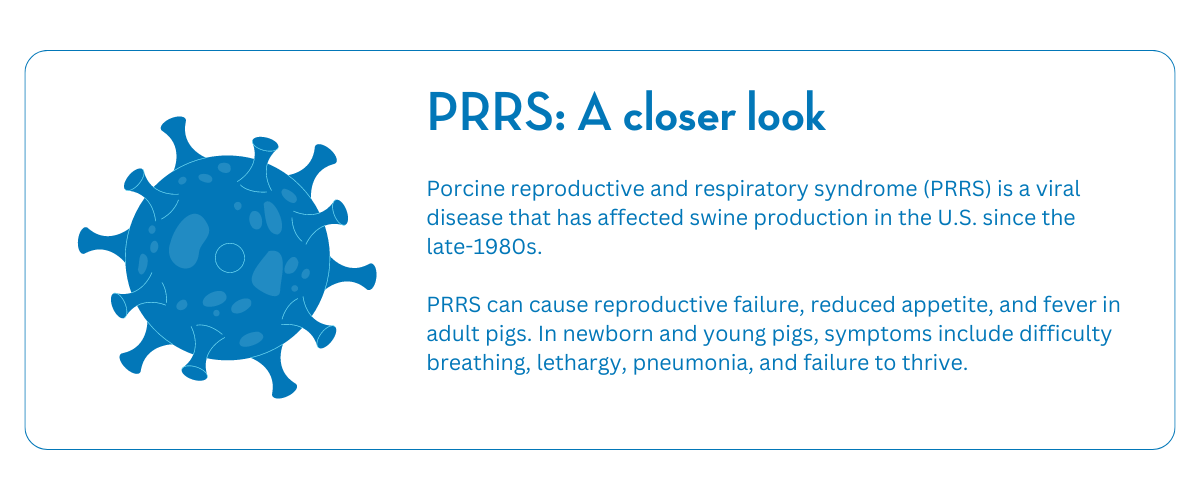AI brings 30 years of data to the real world
Veterinarians have struggled to control an elusive and deadly swine virus for decades. Can AI change that?

Veterinarians have struggled to control an elusive and deadly swine virus for decades. Can AI change that?
Image generated by AI technology
Porcine reproductive and respiratory syndrome (PRRS) virus impacts as much as half of all swine breeding farms in the United States. It’s one of the most costly issues the swine industry faces. The virus now costs the U.S. pork industry $1.2 billion per year in lost production, an 80-percent increase in the last decade.
It’s also among the most sequenced viruses in the world, giving researchers a unique window into how viruses evolve.
An AI-driven initiative started by researchers in the University of Minnesota (UMN) College of Veterinary Medicine (CVM) is harnessing huge amounts of data on PRRS variants to help farmers better understand how the elusive PRRS virus infects herds—and the best course of action for getting pigs healthy again.
PRRS is a ribonucleic acid (RNA) virus, just like the measles virus, SARS-CoV-2, and influenza. These viruses mutate quickly, meaning treatment and prevention efforts are up against a constantly moving target.

Over the last three decades, veterinarians and researchers have been sequencing tens of thousands of PRRS viruses collected from farms around the world. The CVM’s Morrison Swine Health Monitoring Project Database alone houses nearly 30 thousand sequences of PRRS RNA, representing more than half of U.S. swine producers. But the full potential of the data to teach us about the virus has yet to be realized, awaiting advances in machine learning that could take full advantage of the information it stores.
“A better system for grouping PRRS viruses by their genetic similarity has been a recognized need in the industry for almost 20 years. The lack of a good tool for classifying the virus has led to a lot of confusion in the field in terms of tracking outbreaks,” says Kim VanderWaal, PhD, an associate professor in the Department of Veterinary Population Medicine, who is among the CVM researchers spearheading a new AI-based platform. “We now have the computational power and machine-learning tools to actually advance our way of gleaning more information from genetic sequences.”
The novel web tool uses machine learning to compare viral sequences to a database of previously sequenced PRRS viruses and places these sequences in an epidemiological context. The comparison draws on patterns seen in past outbreaks to determine whether the virus circulating on a farm is a variant of concern and potentially where it may have come from.

If a genetic variant bears the hallmarks of previous high-impact variants, the machine-learning platform will flag the new variant as having the potential to behave in the same way. The platform also enables veterinarians to perform quick epidemiological work, such as comparing a new PRRS strain to a previous strain that circulated on a farm, or narrowing down how the outbreak began.
“Vets and practitioners really want to be able to make these interpretations from virus sequences, but it is challenging. It takes special skills to take sequences and understand how the host recognizes the virus,” VanderWaal says.
The new platform will allow someone who is not an expert in sequence analysis to input their viral sequence and understand which group of variants it belongs to. The work is supported by the USDA National Institute of Food and Agriculture and the American Association of Swine Veterinarians.
Farmers and veterinarians can then use all of this information to decide the best course of action. If they determine the virus entered the production from people or animals traveling between farms, they can tailor their biosecurity measures to close those gaps. If the virus on their farm belongs to a strain that is particularly infectious, they may choose to cull the animals before the virus has a chance to spread. They may also be able to determine whether exposure to a previous variant, or a vaccine, will likely offer protection against a new variant. Some vaccine companies update the strains used in their PRRS vaccines based on genetic information.
“Being able to anticipate the next big variant is important,” VanderWaal says.
More than data:
The growing role of artificial intelligence in research at CVM
AI on the prize:
CVM professor sees artificial intelligence as the future for healthier cows and more productive dairy farms
Prediction and prevention:
Research leverages AI to identify dogs at higher risk for cancer